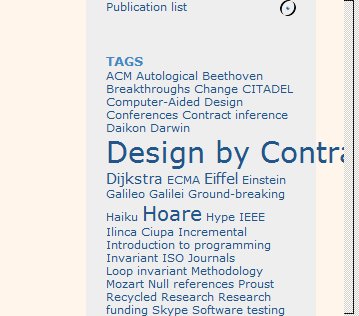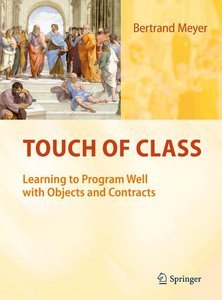[Note: an updated version of this article (June 2011) appears in the Communications of the ACM blog.]
The world of research funding, always a little strange, has of late been prey to a new craze: paradigm-shift mania. We will only fund twenty curly-haired cranky-sounding visionaries in the hope that one of them will invent relativity. The rest of you — bit-players! Petty functionaries! Slaves toiling at incremental research! — should be ashamed of even asking.
Take this from the US National Science Foundation’s current description of funding for Computer Systems Research [1]:
CSR-funded projects will enable significant progress on challenging high-impact problems, as opposed to incremental progress on familiar problems.
The European Research Council is not to be left behind [2]:
Projects being highly ambitious, pioneering and unconventional
Research proposed for funding to the ERC should aim high, both with regard to the ambition of the envisaged scientific achievements as well as to the creativity and originality of proposed approaches, including unconventional methodologies and investigations at the interface between established disciplines. Proposals should rise to pioneering and far-reaching challenges at the frontiers of the field(s) addressed, and involve new, ground-breaking or unconventional methodologies, whose risky outlook is justified by the possibility of a major breakthrough with an impact beyond a specific research domain/discipline.
Frontiers! Breakthrough! Rise! Aim high! Creativity! Risk! Impact! Pass me the adjective bottle. Ground-breaking! Unconventional! Highly ambitious! Major! Far-reaching! Pioneering! Galileo and Pasteur only please — others need not apply.
As everyone knows including the people who write such calls, this is balderdash. First, 99.97% of all research (precise statistic derived from my own ground-breaking research, further funding welcome) is incremental. Second, when a “breakthrough” does happen — the remaining 0.03% — it was often not planned as a breakthrough.
Incremental research is a most glorious (I have my own supply of adjectives) mode of doing science. Beginning PhD students can be forgiven for believing the myth of the lone genius who penetrates the secrets of time and space by thinking aloud during long walks with his best friend [3]; we all, at some stage, shared that delightful delusion. But every researcher, presumably including those who go on to lead research agencies, quickly grows up and learns that it is not how things happen. You read someone else’s solution to a problem, and you improve on it. Any history of science will tell you that for every teenager who from getting hit by a falling apple intuits the structure of the universe there are hundreds of great researchers who look at the state of the art and decide they can do a trifle better.
Here is a still recent example, particularly telling because we have the account from the scientist himself. It would not be much of an exaggeration to characterize the entire field of program proving over the past four decades as a long series of variations on Tony Hoare’s 1969 Axiomatic Semantics paper [4]. Here Hoare’s recollection, from his Turing Award lecture [5]:
In October 1968, as I unpacked my papers in my new home in Belfast, I came across an obscure preprint of an article by Bob Floyd entitled “Assigning Meanings to Programs.” What a stroke of luck! At last I could see a way to achieve my hopes for my research. Thus I wrote my first paper on the axiomatic approach to computer programming, published in the Communications of the ACM in October 1969.
(See also note [6].) Had the research been submitted for funding, we can imagine the reaction: “Dear Sir, as you yourself admit, Floyd has had the basic idea [7] and you are just trying to present the result better. This is incremental research; we are in the paradigm-shift business.” And yet if Floyd had the core concepts right it is Hoare’s paper that reworked and extended them into a form that makes practical semantic specifications and proofs possible. Incremental research at its best.
The people in charge of research programs at the NSF and ERC are themselves scientists and know all this. How come they publish such absurd pronouncements? There are two reasons. One is the typical academic’s fascination with industry and its models. Having heard that venture capitalists routinely fund ten projects and expect one to succeed, they want to transpose that model to science funding; hence the emphasis on “risk”. But the transposition is doubtful because venture capitalists assess their wards all the time and, as soon as they decide a venture is not going to break out, they cut the funding overnight, often causing the company to go under. This does not happen in the world of science: most projects, and certainly any project that is supposed to break new ground, gets funded for a minimum of three to five years. If the project peters out, the purse-holder will only realize it after spending all the money.
The second reason is a sincere desire to avoid mediocrity. Here we can sympathize with the funding executives: they have seen too many “here is my epsilon addition to the latest buzzword” proposals. The last time I was at ECOOP, in 2005, it seemed every paper was about bringing some little twist to aspect-oriented programming. This kind of research benefits no one and it is understandable that the research funders want people to innovate. But telling submitters that every project has to be epochal (surprisingly, “epochal” is missing from the adjectives in the descriptions above — I am sure this will soon be corrected) will not achieve this result.
It achieves something else, good neither for research nor for research funding: promise inflation. Being told that they have to be Darwin or nothing, researchers learn the game and promise the moon; they also get the part about “risk” and emphasize how uncertain the whole thing is and how high the likelihood it will fail. (Indeed, since — if it works — it will let cars run from water seamlessly extracted from the ambient air, and with the excedent produce free afternoon tea.)
By itself this is mostly entertainment, as no one believes the hyped promises. The real harm, however, is to honest scientists who work in the normal way, proposing to bring an important contribution to the solution of an important problem. They risk being dismissed as small-timers with no vision.
Some funding agencies have kept their heads cool. How refreshing, after the above quotes, to read the general description of funding by the Swiss National Science Foundation [8]:
The central criteria for evaluation are the scientific quality, originality and project methodology as well as qualifications and track record of the applicants. Grants are awarded on a competitive basis.
In a few words, it says all there is to say. Quality, originality, methodology, and track record. Will the research be “ground-breaking” or “incremental”? We will know when it is done.
I am convinced that the other agencies will come to their senses and stop the paradigm-shift nonsense. One reason for hope is in the very excesses of the currently fashionable style. The European Research Council quote includes, by my count, nineteen ways of saying that proposals must be daring. Now it is a pretty universal rule of life that someone who finds it necessary to say the same thing nineteen times in a single paragraph does not feel sure about it. He is trying to convince himself. At some point the people in charge will realize that such hype does not breed breakthroughs; it breeds more hype.
Until that happens there is something that some of us can do: refuse to play the game. Of course we are all convinced that our latest idea is the most important one ever conceived by humankind, and we want to picture it in the most favorable light. But we should resist the promise inflation. Such honesty comes at a risk. (I still remember a project proposal, many years ago, which came back with glowing reviews: the topic was important, the ideas right, the team competent. The agency officer’s verdict: reject. The proposers are certain to succeed, so it’s not research.) For some people, there is really no choice but to follow the lead: if your entire career depends on getting external funding, no amount of exhortation will prevent you from saying what the purse-holders want to hear. But those of us who do have a choice (that is to say, will survive even if a project is rejected) should refuse the compromission. We should present our research ideas for what they are.
So: one cheer for incremental research.
Wait, isn’t the phrase supposed to be “two cheers” [9]?
All right, but let’s go at it incrementally. One and one-tenth cheer for incremental research.
References
[1] National Science Foundation, Division of Computer and Network Systems: Computer Systems Research (CSR), at http://www.nsf.gov/funding/pgm_summ.jsp?pims_id=13385.
[2] European Research Council: Advanced Investigators Grant, at http://erc.europa.eu/index.cfmfuseaction=page.display&topicID=66.
[3] The Berne years; see any biography of Albert Einstein.
[4] C.A.R. Hoare: An axiomatic basis for computer programming, in Communications of the ACM, vol. 12, no 10, pages 576–580,583, October 1969.
[5] C.A.R. Hoare: The Emperor’s Old Clothes, in Communications of the ACM, vol. 24, no. 2, pages 75 – 83, February 1981.
[6] In the first version of this essay I wrote “Someone should celebrate the anniversary!”. Moshe Vardi, editor of Communications of the ACM, has informed me that the October 2009 issue will include a retrospective by Hoare on the 1969 paper. I cannot wait to see it.
[7] Robert W. Floyd: Assigning meanings to programs, in Proceedings of the American Mathematical Society Symposia on Applied Mathematics, vol. 19, pp. 19–31, 1967.
[8] Swiss National Science Foundation: Projects – Investigator-Driven Research, at http://www.snf.ch/E/funding/projects/Pages/default.aspx. Disclosure: The SNSF kindly funds some of my research.
[9] E.M. Forster: Two Cheers for Democracy, Edward Arnold, 1951.
VN:F [1.9.10_1130]
Rating: 8.3/10 (3 votes cast)
VN:F [1.9.10_1130]
Rating: +1 (from 3 votes)







 Informatics Europe
Informatics Europe LASER summer school
LASER summer school Propulsion Academy
Propulsion Academy